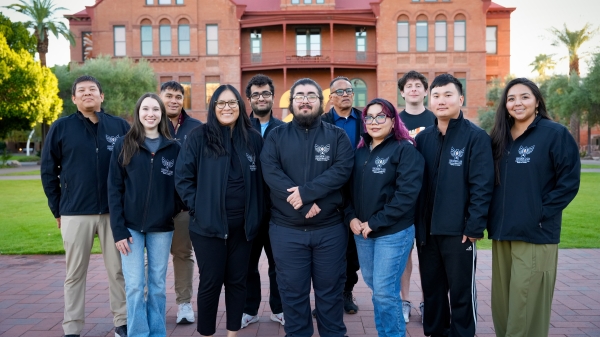Cybersecurity curriculum to pilot in Arizona schools

Students first peek at cybersecurity curriculum.
The average cost of a single data breach is nearly $3.9 million. Globally, the cost of cybercrime is expected to top $2 trillion this year, according to Juniper Research. Yet across the U.S., cybersecurity jobs remain vacant as employers are unable to recruit qualified candidates. That’s just one reason a new cybersecurity curriculum is launching this fall in Arizona K–12 schools, allowing teachers the opportunity to expose their students to cybersecurity at an even younger age.
Arizona State University Professor of Practice Kim Jones is passionate about the importance of exposing youth to cybersecurity to help build an interest in the field. Jones says there are currently over 300,000 unfilled jobs in cybersecurity. His passion resulted in a generous grant from ASU’s Women and Philanthropy to help prepare Arizona students to fill scores of vacant cybersecurity positions.
ASU’s Cybersecurity Education Consortium has been working in collaboration with the Center for the Future of Arizona and Jobs for the Future to build a cyber curriculum that will pilot this fall.
“We are particularly excited to collaborate with ASU to deliver additional curriculum in cybersecurity career exploration,” said Cindy Erwin-Hogberg, director of college and career pathways with the Center for the Future of Arizona. “The opportunities for quality, exciting and fulfilling jobs in this industry are tremendous; yet, cybersecurity is an area that is not well understood by students and families. This curriculum will enable teachers to build their own knowledge as they share these resources with students.”
Jobs for the Future is a non-profit 501 (c)(3) organization that established the Pathways to Prosperity Program to ensure more students have the opportunity to complete high school and move beyond. They have created the “Possible Futures” career exploration curriculum in various subject areas to provide middle school students with the opportunity to understand career options at an early age.
“There are so many reasons to get students thinking about their strengths, interests and passions early on in their development,” said Jonathan Payne, program manager at Jobs for the Future. “In the middle grades, students are making decisions about who they are, how they fit into the world, what they are interested in, as well as, what they are good at and what they aren’t, so it’s essential to help students see the variety of pathways that exist for them in their future to both close the achievement gap, but more importantly to close the aspiration gap. This has to be done in middle school because high school is just too late.”
Jobs for the Future deliberately focuses their “Possible Futures” curriculum on middle school students in an effort to reach students at an age when they are impressionable, and before they have committed to a specific track in high school. They have launched this program in several states, including California, New Mexico, Tennessee and Massachusetts and are currently working with the Center for the Future of Arizona on Year 2 of a pilot to reach Arizona classrooms with their curriculum this fall.
“JFF did not have a cybersecurity curriculum, and we were in the process of developing a cybersecurity curriculum for middle school/early high school students as part of a grant project,” said Trista Zobitz, program coordinator of the Cybersecurity Education Consortium. “This collaboration provides JFF with a cybersecurity curriculum to add to their ‘Possible Futures’ platform and serves as a vehicle for the CEC to reach area schools with cybersecurity content.”
The cybersecurity curriculum consists of 15 lessons covering topics ranging from digital citizenship and threat prevention to encryption and security and includes lessons focused on careers in cybersecurity, so students can connect their interests to specific cyber jobs.
“These decisions have a huge impact on the doors they open, and those they close. Some of the doors they close might close pathways to their possible futures as well,” Payne said. “Careers in cybersecurity abound and with huge growth forecasted in the next decade, it’s a good bet on a great future.”
The pilot program will reach 19 schools across the Phoenix metro area, plus schools in Tucson and Yuma. The Center for the Future of Arizona has trained and worked with 25 teachers who will be implementing the “Possible Futures” curriculum into their classes this fall, reaching over 1,000 students in Arizona alone.
“Our goal was to share cyber curriculum with as many schools as possible, and through this partnership, we will reach multiple states,” Zobitz said. “That is success!”
More Science and technology

Indigenous geneticists build unprecedented research community at ASU
When Krystal Tsosie (Diné) was an undergraduate at Arizona State University, there were no Indigenous faculty she could look to…

Pioneering professor of cultural evolution pens essays for leading academic journals
When Robert Boyd wrote his 1985 book “Culture and the Evolutionary Process,” cultural evolution was not considered a true…

Lucy's lasting legacy: Donald Johanson reflects on the discovery of a lifetime
Fifty years ago, in the dusty hills of Hadar, Ethiopia, a young paleoanthropologist, Donald Johanson, discovered what would…